The Impact Resistance and Mechanical Properties of Recycled Aggregate Concrete with Hooked-End and Crimped Steel Fiber
Abstract
1. Introduction
2. Experimental Program
2.1. Raw Materials
2.2. Mixture Proportions and Sample Preparation
2.3. Testing Methods
2.3.1. Compressive and Splitting Tensile Strength Tests
2.3.2. Flexural Tests
2.3.3. Drop-Weight Impact Resistance Tests
2.3.4. Microstructure Investigations
3. Results and Discussion
3.1. Mechanical Properties
3.1.1. Compressive Strength
3.1.2. Splitting Tensile Strength
3.1.3. Flexural Strength
3.2. Impact Resistance
3.2.1. Impact Test Results
3.2.2. Weibull Distribution
3.3. Microstructure of Steel Fiber-Reinforced RAC
3.3.1. Microstructure of Hardened Cement Paste
3.3.2. Microstructure of the Aggregate–Paste Interface
3.3.3. Microstructure of the Fiber–Paste Interface
4. Conclusions
- The mechanical properties of RAC gradually decreased with increasing RCA substitution ratio. When the substitution ratio of RCA increased from 0% to 50% and 100%, the compressive strength, flexural strength, and splitting tensile strength of RAC decreased by 4–7.8%, 9.5–15.4%, and 3.5–6%, respectively.
- The incorporation of steel fiber significantly increased the mechanical properties of RAC, which could be attributed to the high Young’s modulus, stiffness, and bridging capacity of steel fiber. Specifically, upon adding 1.5% steel fiber into the RAC, mixtures R0-H1.5, R50-H1.5, R100-H1.5, and R100-C1.5 achieved the maximum compressive strength, flexural strength, and splitting tensile strength, which were 19.1–22.3%, 32.2–34.6%, and 28–35% greater compared to common RAC, respectively.
- The impact resistance of SFRAC decreased with increasing RCA substitution ratio, but significantly increased with steel fiber content. Among the different steel fiber combinations, the SFRAC sample containing 1.5% steel fiber had the maximum impact resistance, and its numbers of blows (N1 and N2) were 3.25–4.75 times and 8.78–29.08 times greater compared to the plain RAC specimens, respectively. The improvement effect of HF on the impact resistance of RAC was more significant than that of CF.
- The correlation coefficient R2 values obtained following the statistical analysis of the impact performance of concrete were above or equal to 0.806, exceeding the recommended limit value reported by previous research, which indicated that the distribution characteristics of SFRAC impact obeyed the two-parameter Weibull distribution.
- With increasing RCA replacement ratio, the density of the hardened cement paste decreased but the pores increased. There were a large number of pores and dispersed gel particles observed in the ITZ between cement paste and RCA, and the ITZ between the RCA and cement paste was more obvious compared to the NCA specimen. The connection between steel fibers and cement paste was better than that between the aggregates and cement paste. The wavy surface of CF increased the water retention capacity of the fiber surface in the hydrated cement matrix, resulting in a worse bonding performance of CF compared to HF.
Author Contributions
Funding
Institutional Review Board Statement
Informed Consent Statement
Data Availability Statement
Conflicts of Interest
Nomenclature
| RCA | recycled coarse aggregate |
| CDW | construction and demolition waste |
| RAC | recycled aggregate concrete |
| ITZ | interfacial transition zone |
| SEM | scanning electron microscope |
| SFRAC | steel fiber recycled aggregate concrete |
| NAC | natural aggregate concrete |
| HF | Hooked-end steel fiber |
| CF | crimped steel fiber |
| N1 | the number of blows for initial crack |
| N2 | the number of blows for ultimate failure |
| Wi | impact absorption energy (J) |
| Ni | the number of blows |
| PINBP | The percentage increase in the number of post-initial-crack blows until failure |
| C–S–H | calcium silicate hydrates |
| Ca(OH)2 | calcium hydroxide |
References
- Li, H.; Zhang, Y.; Wu, L.; Jin, Y.; Gong, Y.; Li, A.; Li, J.; Li, F. Recycled aggregates from construction and demolition waste as wetland substrates for pollutant removal. J. Clean. Prod. 2021, 311, 127766. [Google Scholar] [CrossRef]
- Tam, V.W.Y.; Soomro, M.; Evangelista, A.C.J. A review of recycled aggregate in concrete applications (2000–2017). Constr. Build. Mater. 2018, 172, 272–292. [Google Scholar] [CrossRef]
- Domingo, N.; Luo, H. Canterbury earthquake construction and demolition waste management: Issues and improvement suggestions. Int. J. Disaster Risk Reduct. 2017, 22, 130–138. [Google Scholar] [CrossRef]
- Eurostat. Waste Statistics. 2018. Available online: https://ec.europa.eu/eurostat/statistics-explained/index.php/Waste_statistics#Total_waste_generation (accessed on 2 April 2021).
- EPA. Construction and Demolition: Material-Specific Data|Facts and Figures about Materials, Waste and Recycling|US EPA. 2018. Available online: https://www.epa.gov/facts-and-figures-about-materials-waste-and-recycling/construc-tion-and-demolition-material-specific (accessed on 2 April 2020).
- Zhang, J.; Zhang, A.; Huang, C.; Yu, H.; Zhou, C. Characterising the resilient behaviour of pavement subgrade with construction and demolition waste under Freeze–Thaw cycles. J. Clean. Prod. 2021, 300, 126702. [Google Scholar] [CrossRef]
- Huang, B.; Wang, X.; Kua, H.; Geng, Y.; Bleischwitz, R.; Ren, J. Construction and demolition waste management in China through the 3R principle. Resour. Conserv. Recycl. 2018, 129, 36–44. [Google Scholar] [CrossRef]
- World Economic Forum. Shaping the Future of Construction, World Economic Forum (WEF). 2016. Available online: http://www3.weforum.org/docs/WEF_Shaping_the_Future_of_Construction_full_report__.pdf (accessed on 5 April 2021).
- PMR. Global Market Study on Construction Aggregates: Crushed Stone Product Type Segment Projected to Register High Value and Volume CAGR during 2017–2025; Persistence Market Research: New York, NY, USA, 2017; p. 235. [Google Scholar]
- De Juan, M.S.; Gutiérrez, P.A. Study on the influence of attached mortar content on the properties of recycled concrete aggregate. Constr. Build. Mater. 2009, 23, 872–877. [Google Scholar] [CrossRef]
- Xie, J.; Huang, L.; Guo, Y.; Li, Z.; Fang, C.; Li, L.; Wang, J. Experimental study on the compressive and flexural behaviour of recycled aggregate concrete modified with silica fume and fibres. Constr. Build. Mater. 2018, 178, 612–623. [Google Scholar] [CrossRef]
- Rao, M.C.; Bhattacharyya, S.K.; Barai, S.V. Influence of field recycled coarse aggregate on properties of concrete. Mater. Struct. 2011, 44, 205–220. [Google Scholar] [CrossRef]
- Wang, Y.; Hughes, P.; Niu, H.; Fan, Y. A new method to improve the properties of recycled aggregate concrete: Composite addition of basalt fiber and nano-silica. J. Clean. Prod. 2019, 236, 117602. [Google Scholar] [CrossRef]
- Mohammed, S.I.; Najim, K.B. Mechanical strength, flexural behavior and fracture energy of Recycled Concrete Aggregate self-compacting concrete. Structures 2019, 23, 34–43. [Google Scholar] [CrossRef]
- Zhou, C.; Chen, Z. Mechanical properties of recycled concrete made with different types of coarse aggregate. Constr. Build. Mater. 2017, 134, 497–506. [Google Scholar] [CrossRef]
- Debieb, F.; Courard, L.; Kenai, S.; Degeimbre, R. Mechanical and durability properties of concrete using contaminated recycled aggregates. Cem. Concr. Compos. 2010, 32, 421–426. [Google Scholar] [CrossRef]
- Silva, R.; de Brito, J.; Dhir, R. Prediction of the shrinkage behavior of recycled aggregate concrete: A review. Constr. Build. Mater. 2015, 77, 327–339. [Google Scholar] [CrossRef]
- Yildirim, S.T.; Meyer, C.; Herfellner, S. Effects of internal curing on the strength, drying shrinkage and freeze–thaw resistance of concrete containing recycled concrete aggregates. Constr. Build. Mater. 2015, 91, 288–296. [Google Scholar] [CrossRef]
- Tam, V.W.; Kotrayothar, D.; Xiao, J. Long-term deformation behaviour of recycled aggregate concrete. Constr. Build. Mater. 2015, 100, 262–272. [Google Scholar] [CrossRef]
- Ali, B.; Qureshi, L.A. Influence of glass fibers on mechanical and durability performance of concrete with recycled aggregates. Constr. Build. Mater. 2019, 228, 116783. [Google Scholar] [CrossRef]
- Thomas, J.; Ramaswamy, A. Mechanical Properties of Steel Fiber-Reinforced Concrete. J. Mater. Civ. Eng. 2007, 19, 385–392. [Google Scholar] [CrossRef]
- Gao, D.; Zhang, L.; Nokken, M. Compressive behavior of steel fiber reinforced recycled coarse aggregate concrete designed with equivalent cubic compressive strength. Constr. Build. Mater. 2017, 141, 235–244. [Google Scholar] [CrossRef]
- Ramesh, R.B.; Mirza, O.; Kang, W. Mechanical properties of steel fiber reinforced recycled aggregate concrete. Struct. Concr. 2018, 20, 745–755. [Google Scholar] [CrossRef]
- Gao, D.; Zhang, L. Flexural performance and evaluation method of steel fiber reinforced recycled coarse aggregate concrete. Constr. Build. Mater. 2018, 159, 126–136. [Google Scholar] [CrossRef]
- Afroughsabet, V.; Biolzi, L.; Ozbakkaloglu, T. Influence of double hooked-end steel fibers and slag on mechanical and durability properties of high performance recycled aggregate concrete. Compos. Struct. 2017, 181, 273–284. [Google Scholar] [CrossRef]
- Zaid, O.; Mukhtar, F.M.; Rebeca, M.; El Sherbiny, M.G.; Mohamed, A.M. Characteristics of high-performance steel fiber reinforced recycled aggregate concrete utilizing mineral filler. Case Stud. Constr. Mater. 2022, 16, e00939. [Google Scholar] [CrossRef]
- Zong, S.; Liu, Z.; Li, S.; Lu, Y.; Zheng, A. Stress-strain behaviour of steel-fibre-reinforced recycled aggregate concrete under axial tension. J. Clean. Prod. 2020, 278, 123248. [Google Scholar] [CrossRef]
- Xie, J.-H.; Guo, Y.-C.; Liu, L.-S.; Xie, Z.-H. Compressive and flexural behaviours of a new steel-fibre-reinforced recycled aggregate concrete with crumb rubber. Constr. Build. Mater. 2015, 79, 263–272. [Google Scholar] [CrossRef]
- Kotwal, S.; Singh, H.; Kumar, R. Experimental investigation of Steel Fibre reinforced Self Compacting Concrete (SCC) using recycled aggregates as partial replacement of coarse aggregates. Mater. Today Proc. 2022, 48, 1032–1037. [Google Scholar] [CrossRef]
- Ding, Y.; Li, D.; Zhang, Y.; Azevedo, C. Experimental investigation on the composite effect of steel rebars and macro fibers on the impact behavior of high performance self-compacting concrete. Constr. Build. Mater. 2017, 136, 495–505. [Google Scholar] [CrossRef]
- Gupta, T.; Sharma, R.K.; Chaudhary, S. Impact resistance of concrete containing waste rubber fiber and silica fume. Int. J. Impact Eng. 2015, 83, 76–87. [Google Scholar] [CrossRef]
- Omidinasab, F.; Moazami Goodarzi, S.; Sahraei Moghadam, A. Characterization and Optimization of Mechanical and Impact Properties of Steel Fiber Reinforced Recycled Concrete. Int. J. Civ. Eng. 2021, 20, 41–55. [Google Scholar] [CrossRef]
- GB/T 175-2007; Common Portland Cement. China National Standardization Administration: Beijing, China, 2007.
- Zhao, G.; Peng, S.; Huang, C. Steel Fiber Reinforced Concrete Structure; China Architecture & Building Press: Beijing, China, 1999. [Google Scholar]
- JGJ/T 221-2010; Technical Specification for Application of Fiber Reinforced Concrete. China National Standardization Administration: Beijing, China, 2010.
- GB/T 50080-2016; Standard for Test Method of Mechanical Properties on Ordinary Concrete. Ministry of Housing and Urban-Rural Development of the People’s Republic of China: Beijing, China, 2016.
- ACI 544.2R-89; Measurement of Properties of Fiber Reinforced Concrete Reported. American Concrete Institute: Farmington Hills, MI, USA, 1996.
- GB/T 21120-2007; Synthetic Fibers for Cement, Cement Mortar and Concrete. China National Standardization Administration: Beijing, China, 2007.
- Li, J.J.; Niu, J.G.; Wan, C.J.; Jin, B.; Yin, Y.L. Investigation on mechanical properties and microstructure of high performance polypropylene fiber reinforced lightweight aggregate concrete. Constr. Build. Mater. 2016, 118, 27–35. [Google Scholar] [CrossRef]
- Elhakam, A.A.; Mohamed, A.E.; Awad, E. Influence of self-healing, mixing method and adding silica fume on mechanical properties of recycled aggregates concrete. Constr. Build. Mater. 2012, 35, 421–427. [Google Scholar] [CrossRef]
- Behera, M.; Bhattacharyya, S.; Minocha, A.; Deoliya, R.; Maiti, S. Recycled aggregate from C&D waste & its use in concrete—A breakthrough towards sustainability in construction sector: A review. Constr. Build. Mater. 2014, 68, 501–516. [Google Scholar] [CrossRef]
- Shi, X.; Collins, F.; Zhao, X.; Wang, Q. Mechanical properties and microstructure analysis of fly ash geopolymeric recycled concrete. J. Hazard. Mater. 2012, 237, 20–29. [Google Scholar] [CrossRef]
- Ali, B.; Raza, S.S.; Kurda, R.; Alyousef, R. Synergistic effects of fly ash and hooked steel fibers on strength and durability properties of high strength recycled aggregate concrete. Resour. Conserv. Recycl. 2021, 168, 105444. [Google Scholar] [CrossRef]
- Xiong, C.; Li, Q.; Lan, T.; Li, H.; Long, W.; Xing, F. Sustainable use of recycled carbon fiber reinforced polymer and crumb rubber in concrete: Mechanical properties and ecological evaluation. J. Clean. Prod. 2021, 279, 123624. [Google Scholar] [CrossRef]
- Yao, W.; Li, J.; Wu, K. Mechanical properties of hybrid fiber-reinforced concrete at low fiber volume fraction. Cem. Concr. Res. 2003, 33, 27–30. [Google Scholar] [CrossRef]
- Dilbas, H.; Şimşek, M.; Çakır, Ö. An investigation on mechanical and physical properties of recycled aggregate concrete (RAC) with and without silica fume. Constr. Build. Mater. 2014, 61, 50–59. [Google Scholar] [CrossRef]
- Nassar, R.-U.; Soroushian, P. Strength and durability of recycled aggregate concrete containing milled glass as partial replacement for cement. Constr. Build. Mater. 2012, 29, 368–377. [Google Scholar] [CrossRef]
- Tabatabaeian, M.; Khaloo, A.; Joshaghani, A.; Hajibandeh, E. Experimental investigation on effects of hybrid fibers on rheological, mechanical, and durability properties of high-strength SCC. Constr. Build. Mater. 2017, 147, 497–509. [Google Scholar] [CrossRef]
- Abid, S.R.; Abdul-Hussein, M.L.; Ayoob, N.S.; Ali, S.H.; Kadhum, A.L. Repeated drop-weight impact tests on self-compacting concrete reinforced with micro-steel fiber. Heliyon 2020, 6, e03198. [Google Scholar] [CrossRef]
- Ramkumar, K.B.; Kannan Rajkumar, P.R. Reinforcing self-compacting concrete with hybrid hooked-end and micro-steel fibres for improving workability and preventing cracks in construction. Case Stud. Constr. Mater. 2022, 17, e01274. [Google Scholar] [CrossRef]
- Murali, G.; Santhi, A.S.; Ganesh, G.M. Impact Resistance and Strength Reliability of Fiber-reinforced Concrete in Bending under Drop Weight Impact Load. Int. J. Technol. 2014, 5, 111. [Google Scholar] [CrossRef]
- Prasad, N.; Murali, G. Exploring the impact performance of functionally-graded preplaced aggregate concrete incorporating steel and polypropylene fibres. J. Build. Eng. 2020, 35, 102077. [Google Scholar] [CrossRef]
- Arora, S.; Singh, S. Analysis of flexural fatigue failure of concrete made with 100% Coarse Recycled Concrete Aggregates. Constr. Build. Mater. 2016, 102, 782–791. [Google Scholar] [CrossRef]
- Ali, M.; Soliman, A.; Nehdi, M. Hybrid-fiber reinforced engineered cementitious composite under tensile and impact loading. Mater. Des. 2017, 117, 139–149. [Google Scholar] [CrossRef]
- Mastali, M.; Dalvand, A.; Sattarifard, A.; Illikainen, M. Development of eco-efficient and cost-effective reinforced self-consolidation concretes with hybrid industrial/recycled steel fibers. Constr. Build. Mater. 2018, 166, 214–226. [Google Scholar] [CrossRef]
- Murali, G.; Abid, S.R.; Amran, Y.H.M.; Abdelgader, H.S.; Fediuk, R.; Susrutha, A.; Poonguzhali, K. Impact performance of novel multi-layered prepacked aggregate fibrous composites under compression and bending. Structures 2020, 28, 1502–1515. [Google Scholar] [CrossRef]
- Saghafi, A.; Mirhabibi, A.; Yari, G. Improved linear regression method for estimating Weibull parameters. Theor. Appl. Fract. Mech. 2009, 52, 180–182. [Google Scholar] [CrossRef]
- Rahmani, T.; Kiani, B.; Shekarchizadeh, M.; Safari, A. Statistical and experimental analysis on the behavior of fiber reinforced concretes subjected to drop weight test. Constr. Build. Mater. 2012, 37, 360–369. [Google Scholar] [CrossRef]
- Alfayez, S.; Ali, M.A.E.M.; Nehdi, M.L. Eco-Efficient Fiber-Reinforced Preplaced Recycled Aggregate Concrete under Impact Loading. Infrastructures 2019, 4, 37. [Google Scholar] [CrossRef]
- Asrani, N.P.; Murali, G.; Parthiban, K.; Surya, K.; Prakash, A.; Rathika, K.; Chandru, U. A feasibility of enhancing the impact resistance of hybrid fibrous geopolymer composites: Experiments and modelling. Constr. Build. Mater. 2019, 203, 56–68. [Google Scholar] [CrossRef]
- He, W.; Kong, X.; Fu, Y.; Zhou, C.; Zheng, Z. Experimental investigation on the mechanical properties and microstructure of hybrid fiber reinforced recycled aggregate concrete. Constr. Build. Mater. 2020, 261, 120488. [Google Scholar] [CrossRef]
- Dong, J.; Wang, Q.; Guan, Z. Material properties of basalt fibre reinforced concrete made with recycled earthquake waste. Constr. Build. Mater. 2017, 130, 241–251. [Google Scholar] [CrossRef]
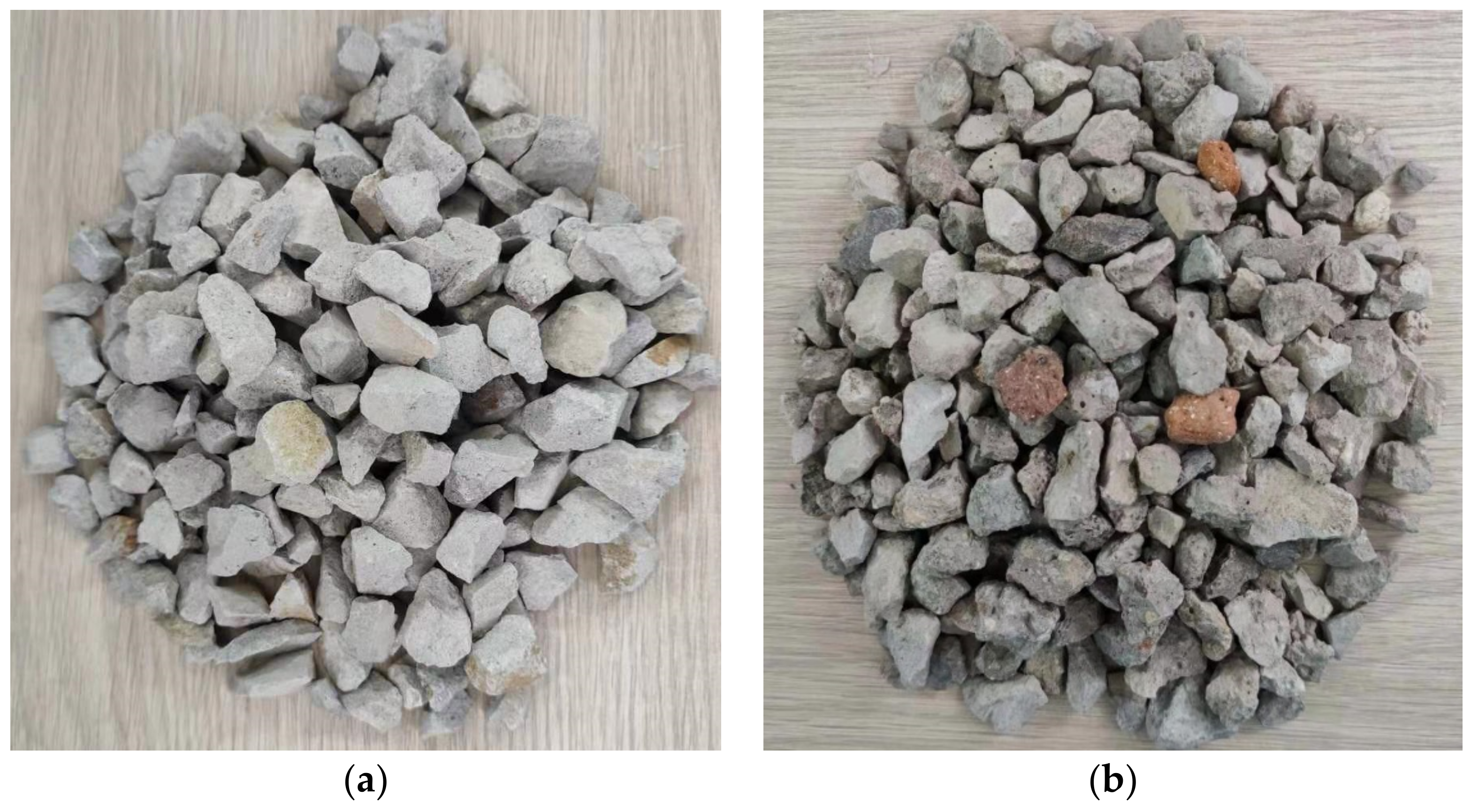
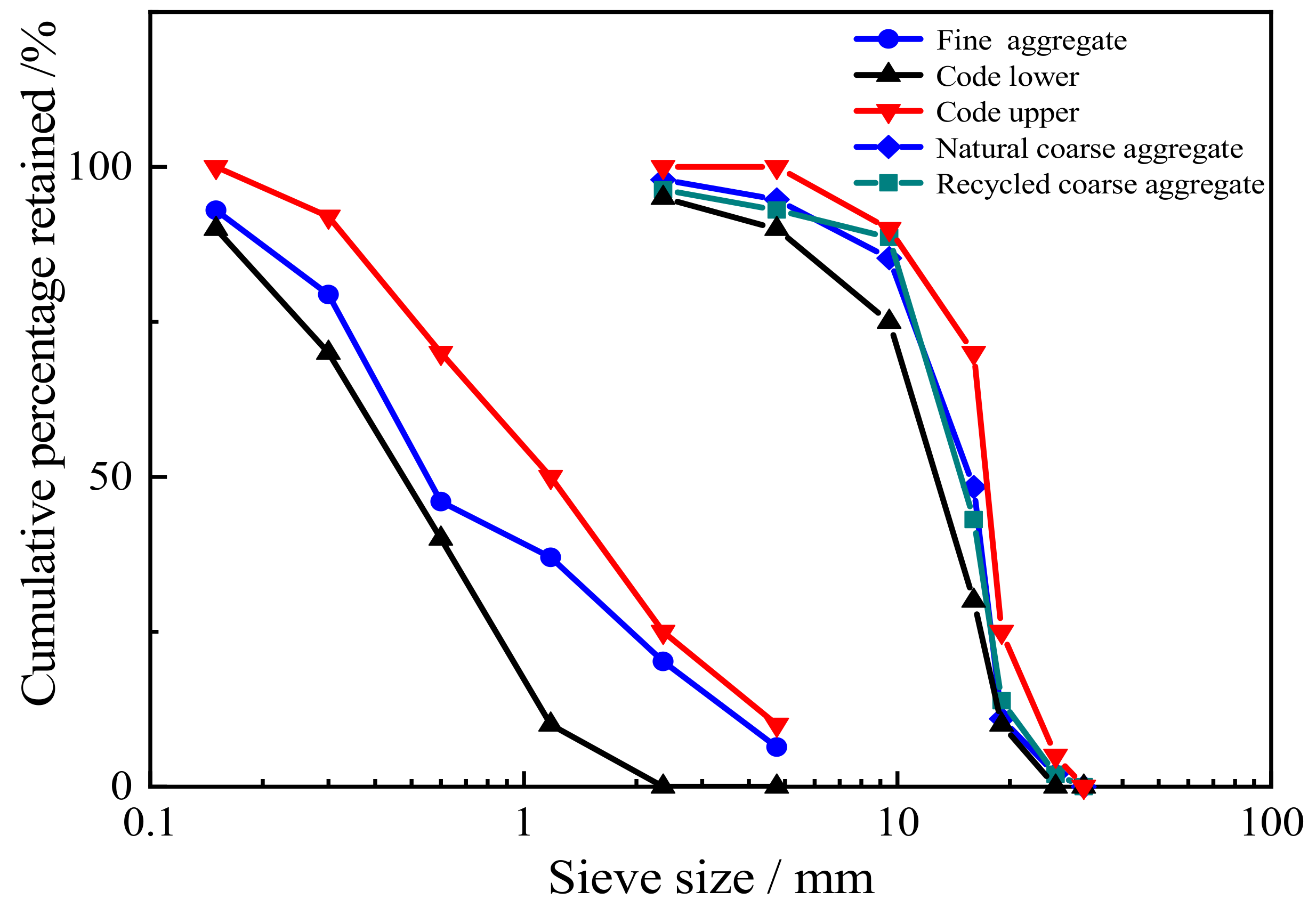

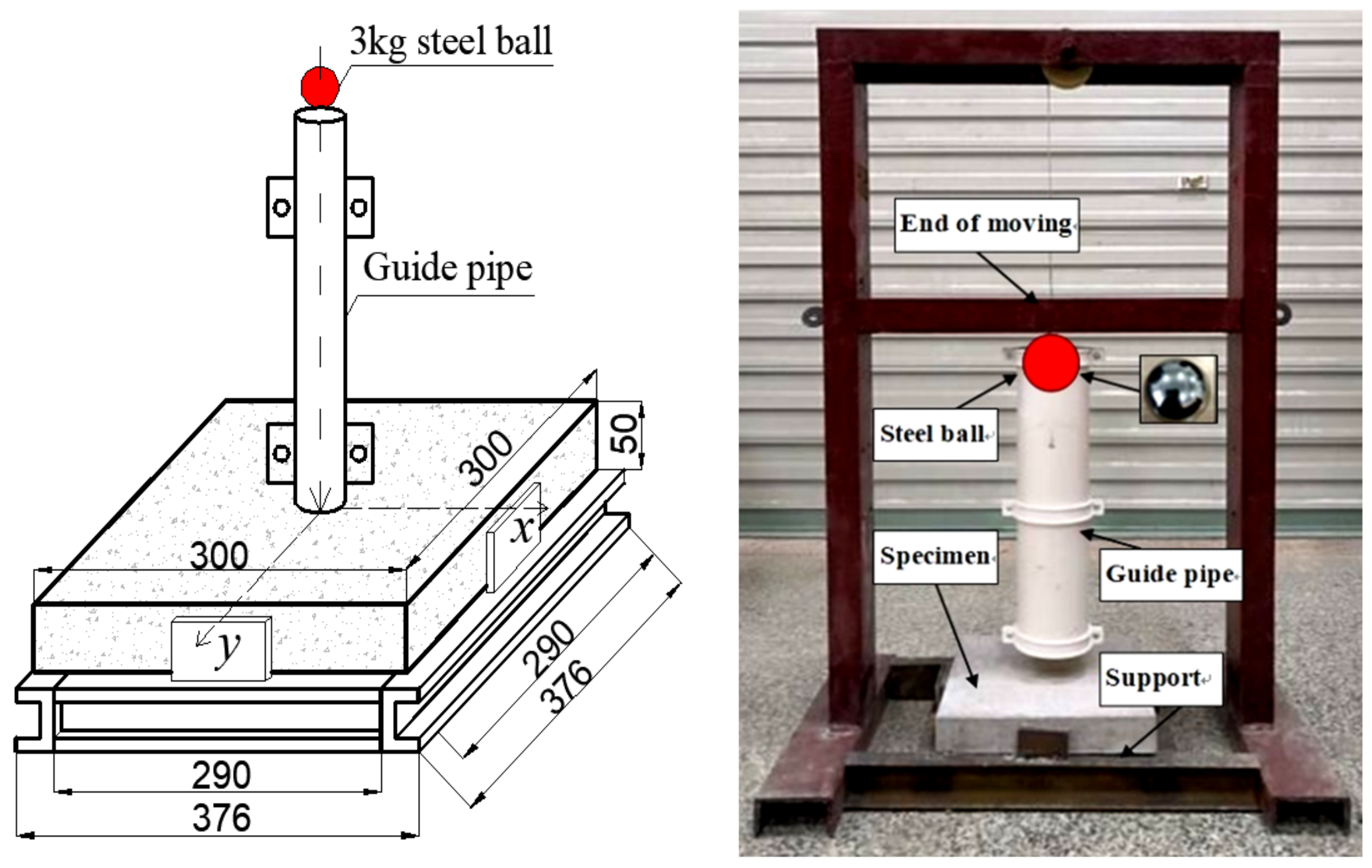
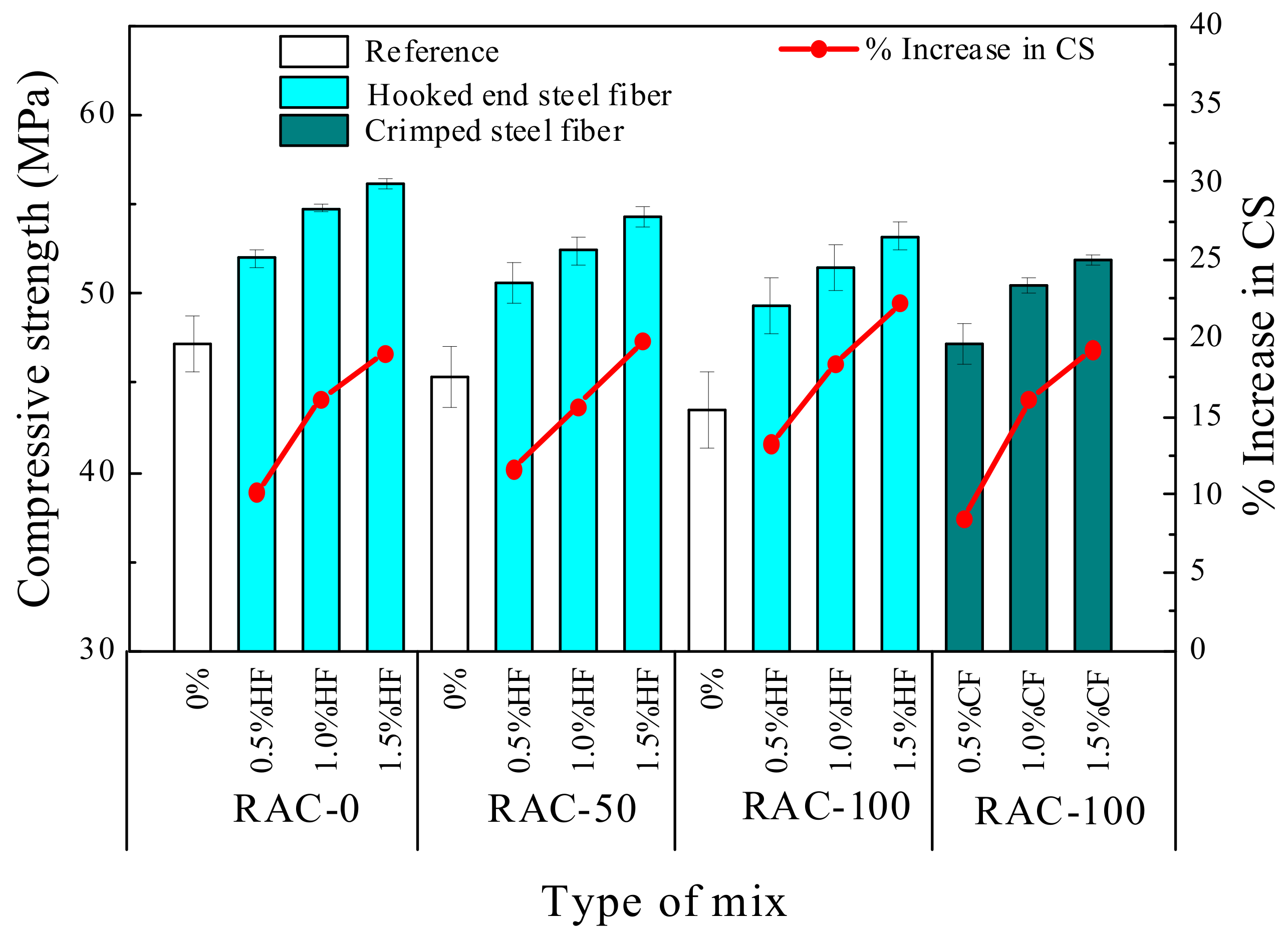
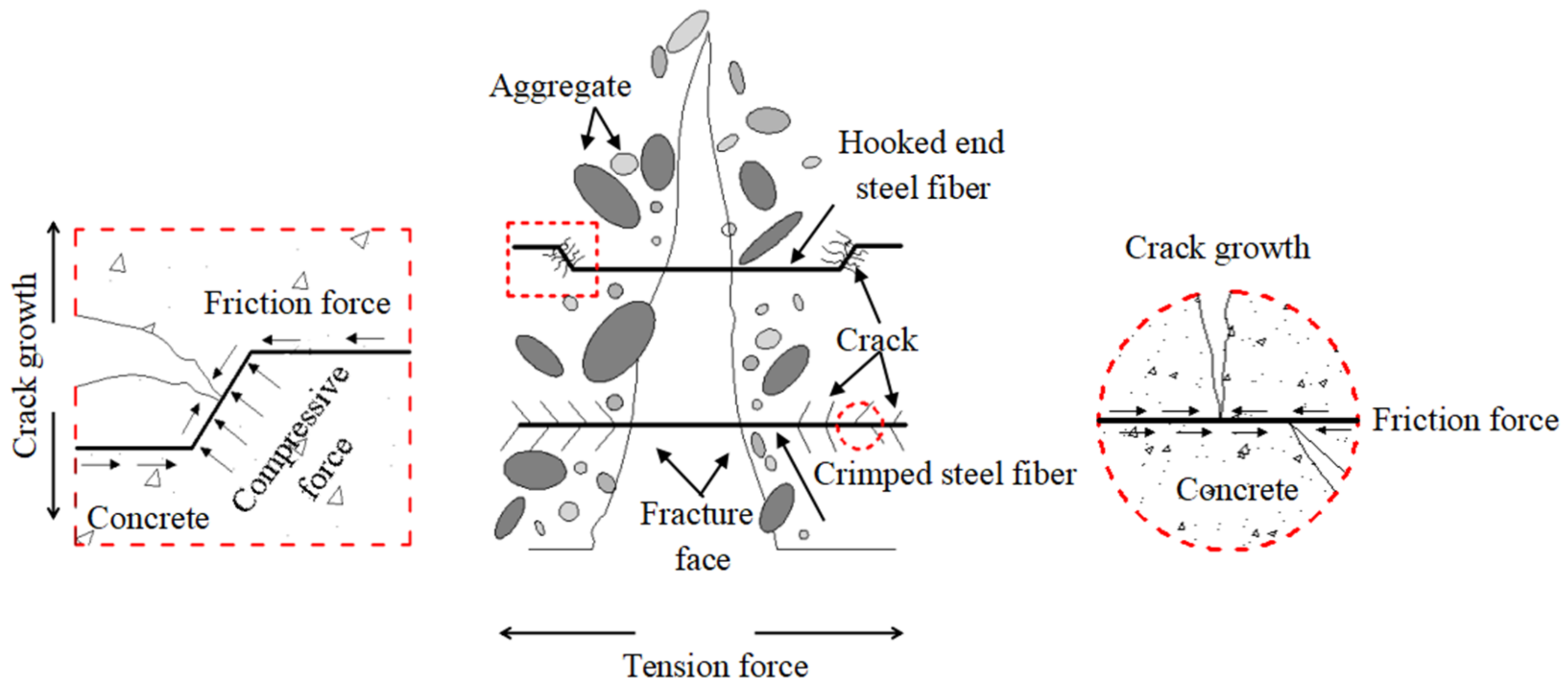
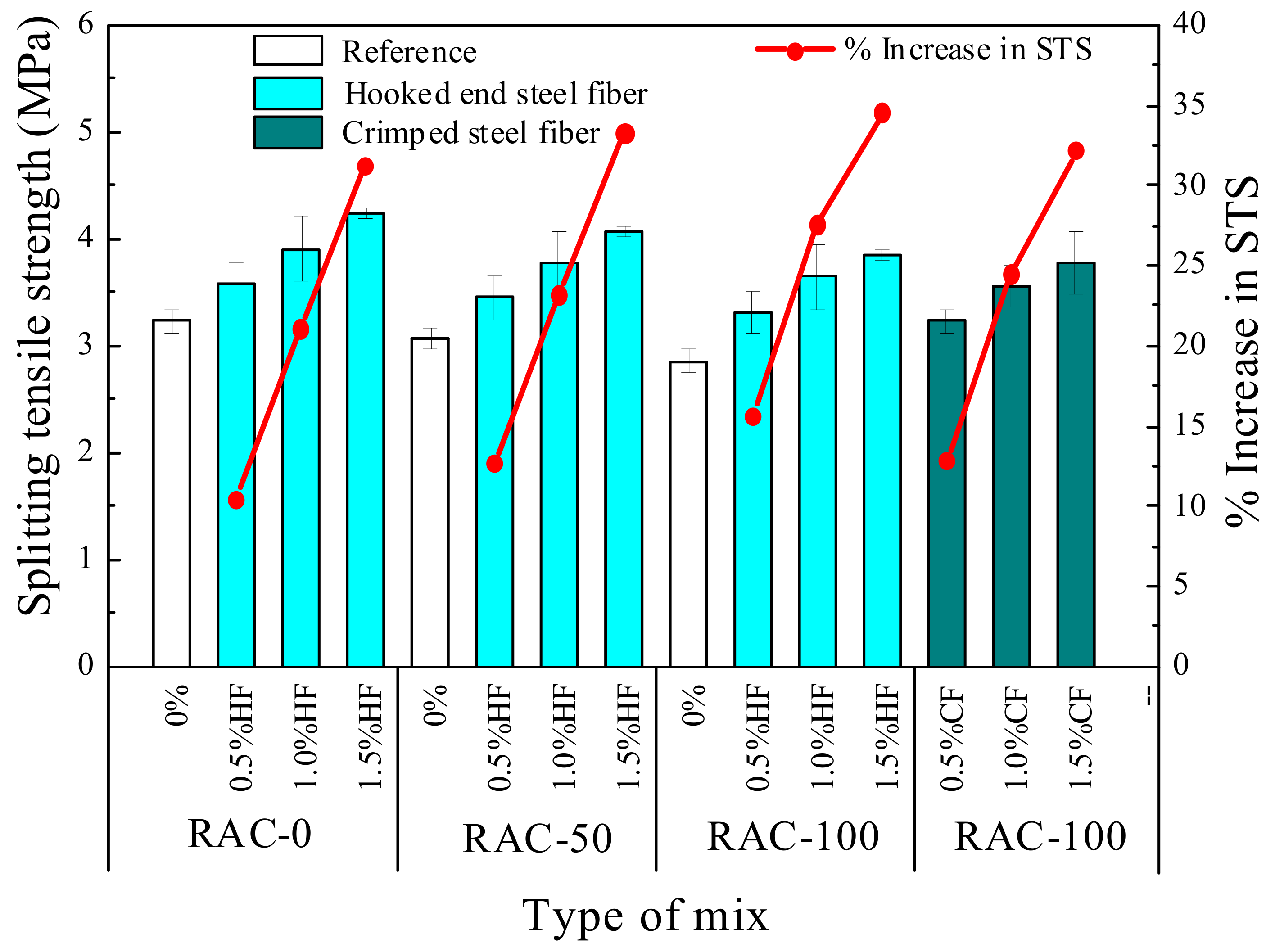
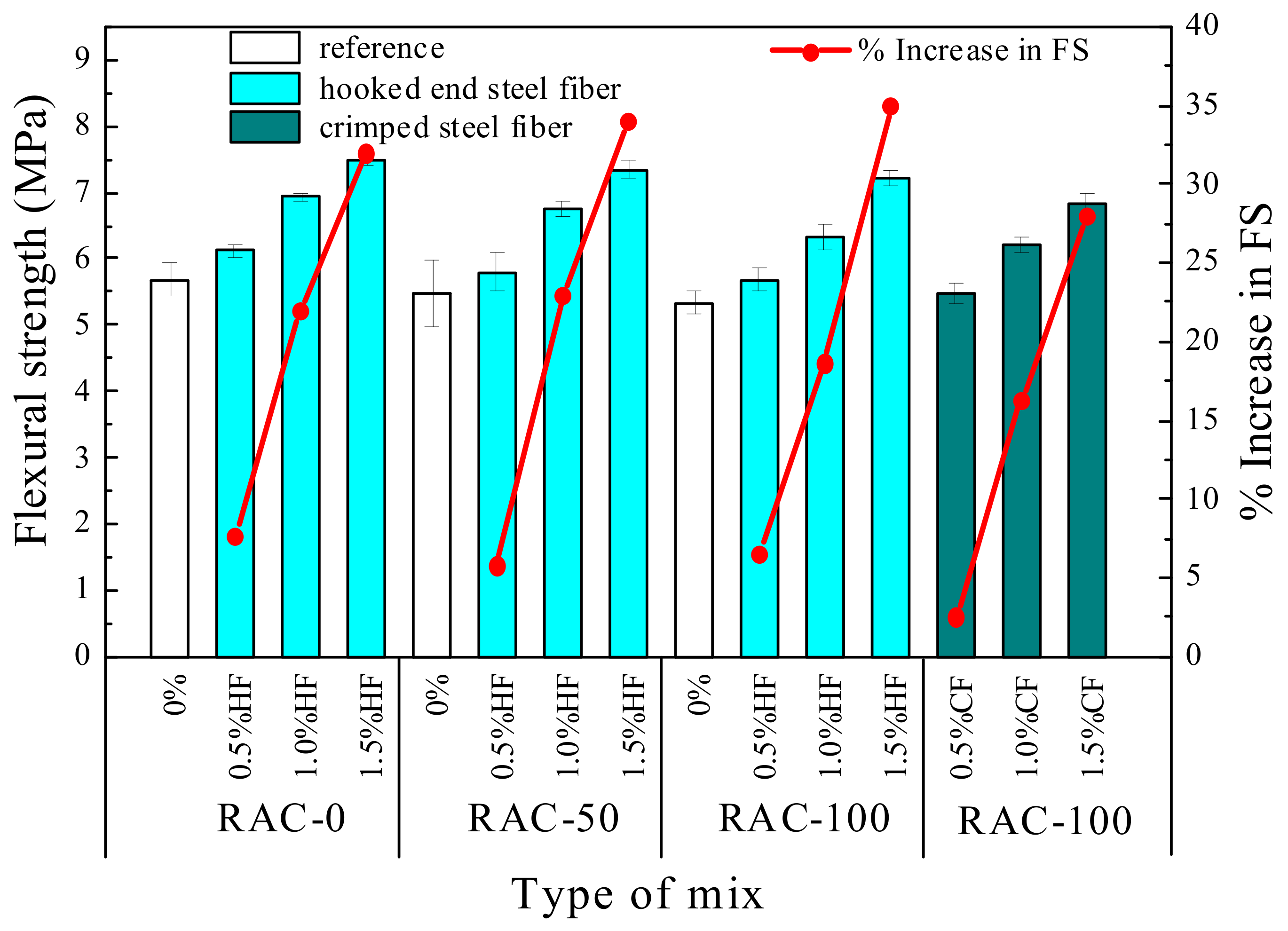
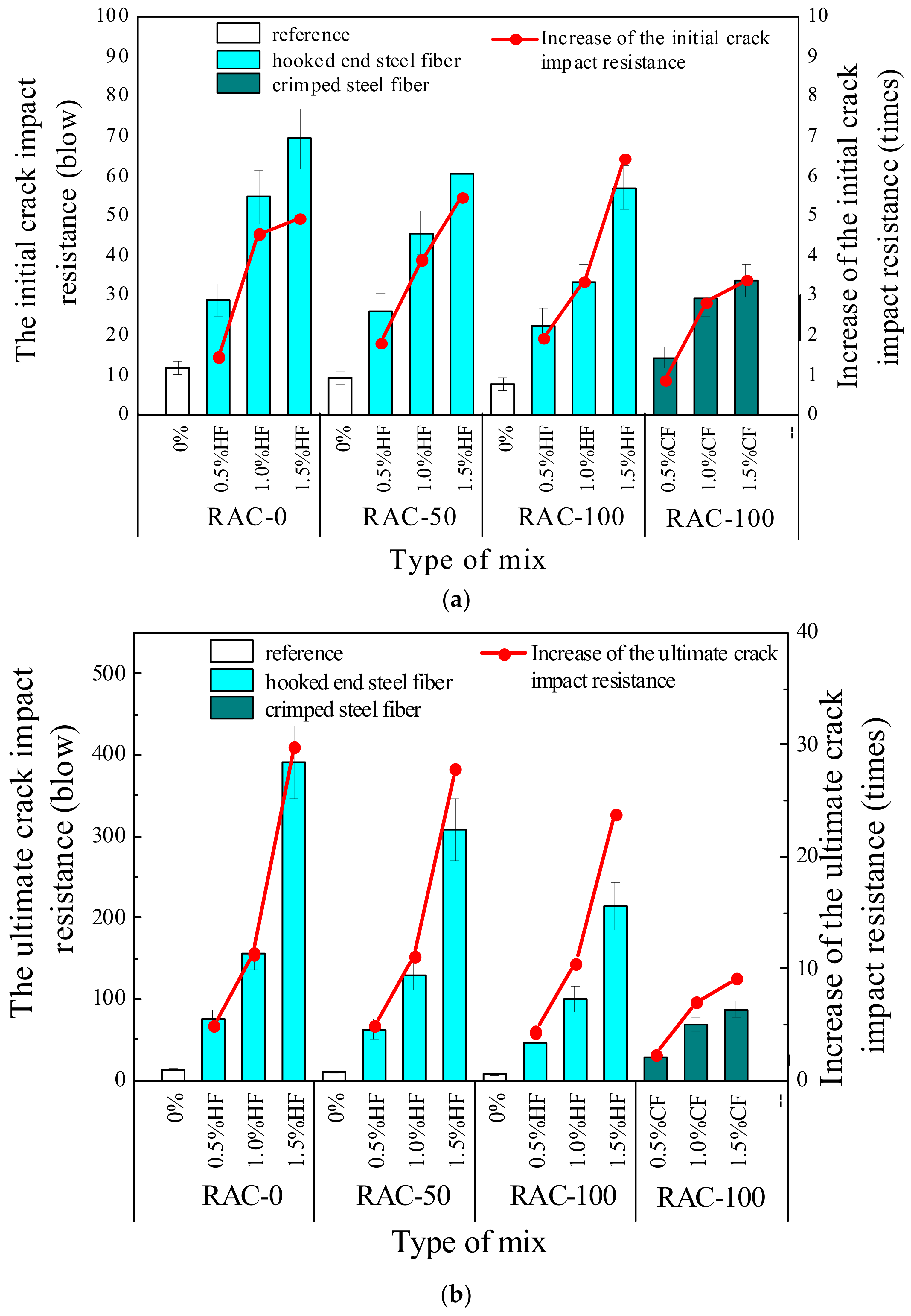
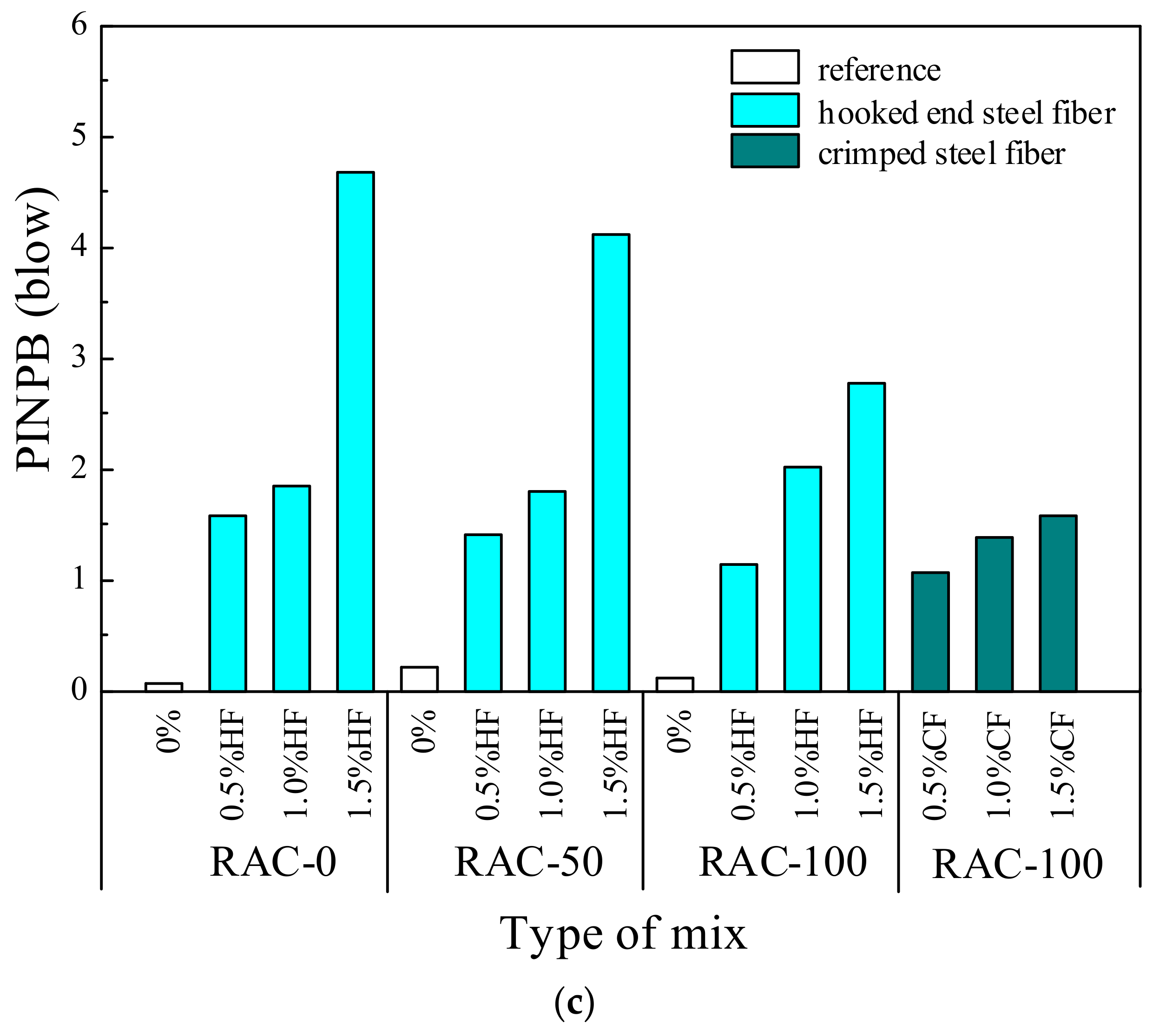

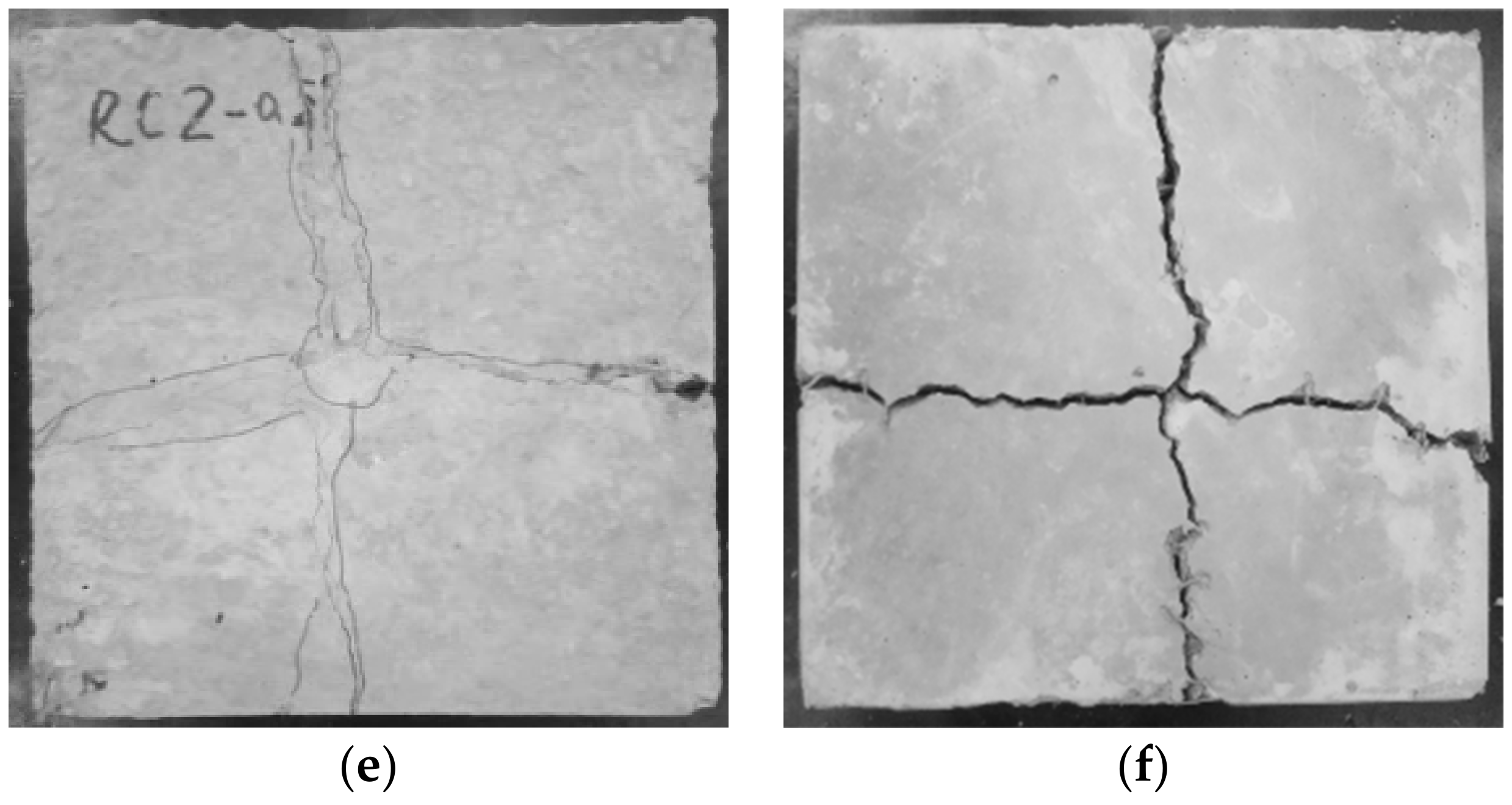
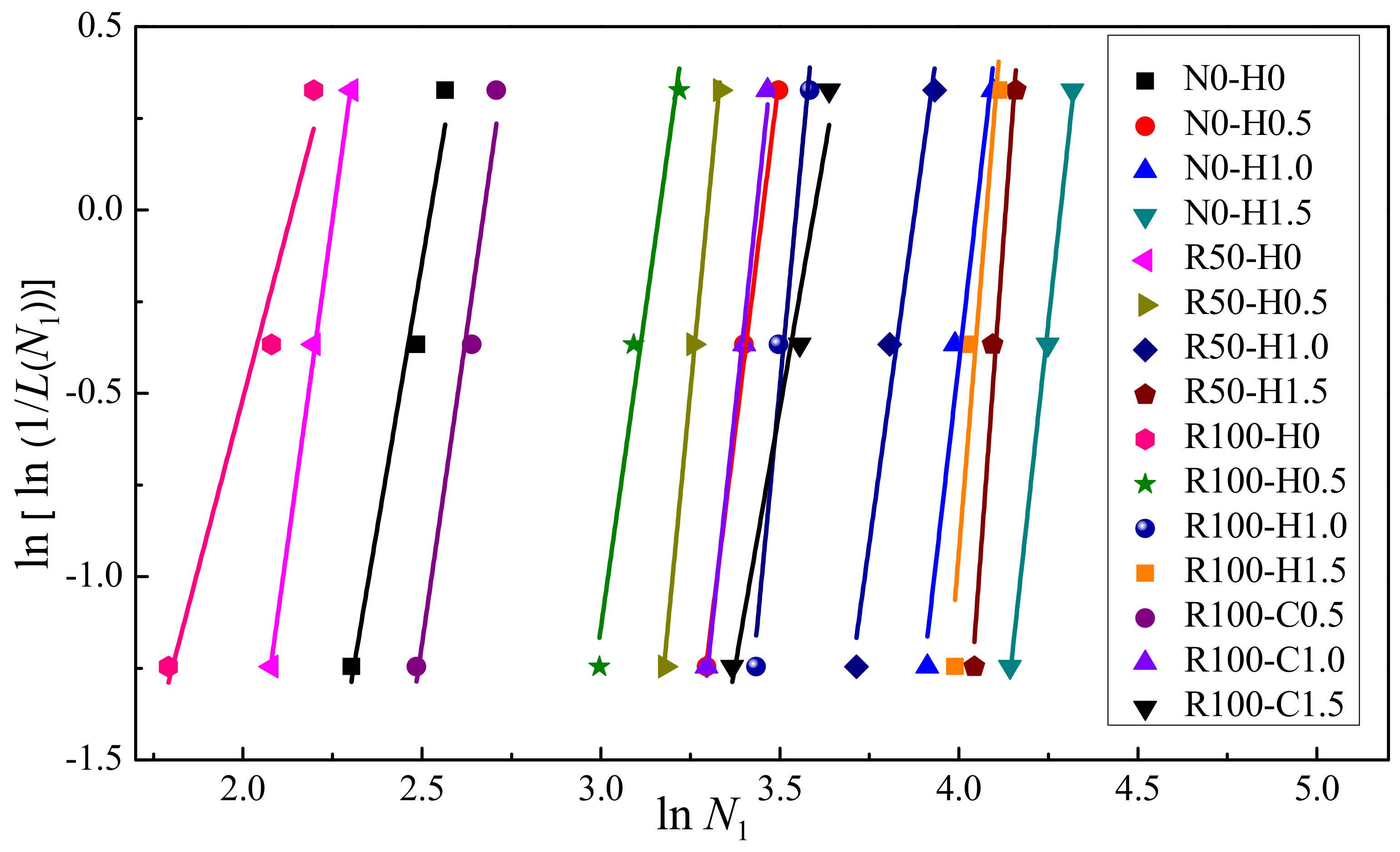

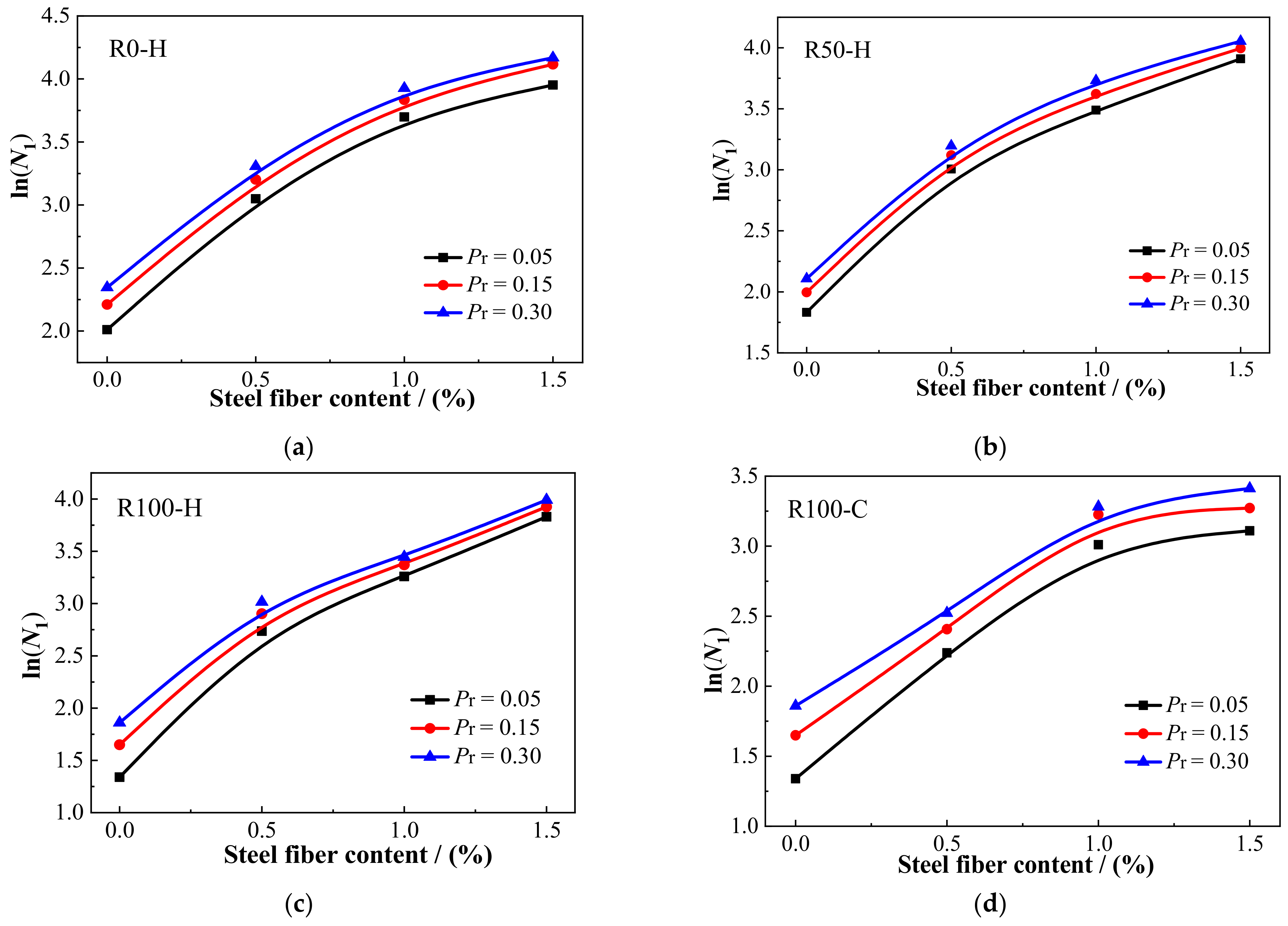

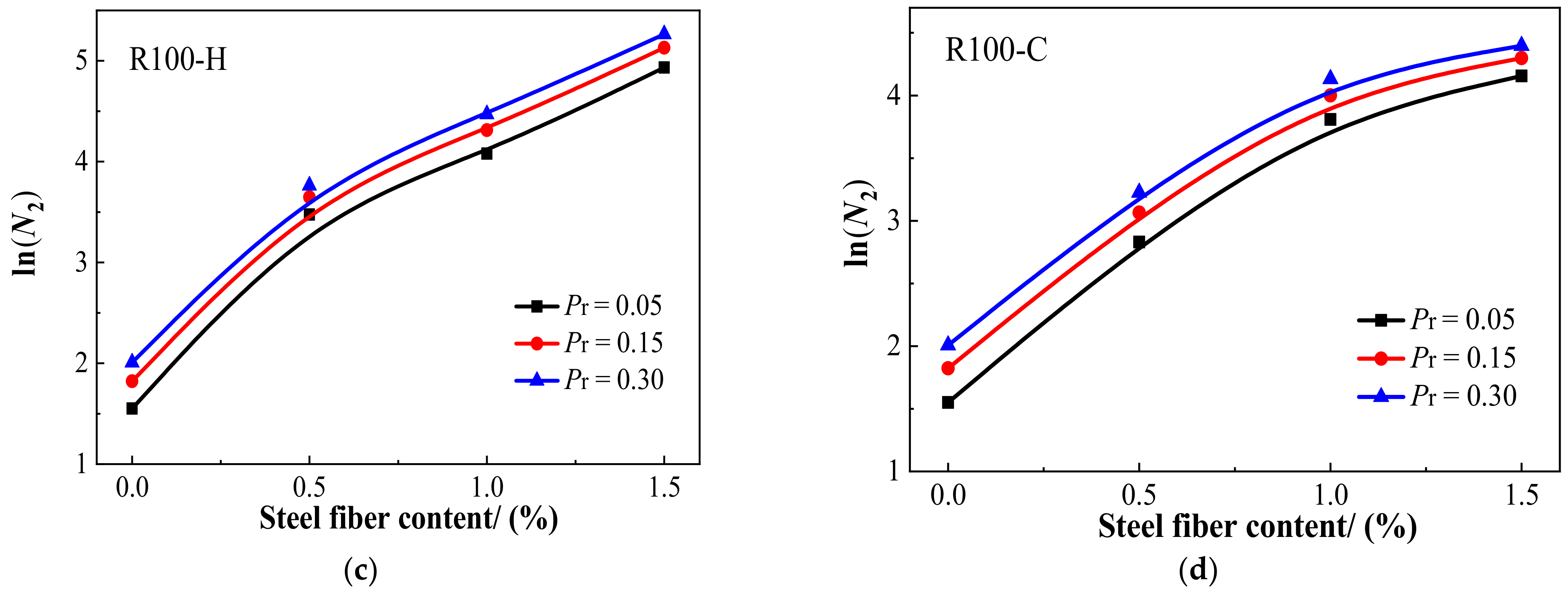



| Chemical Characteristics | Result | Physical Characteristics | Result |
|---|---|---|---|
| SiO2 | 22.5% | Specific gravity | 3.11 |
| Al2O3 | 5.02% | Specific surface | 358 m2/kg |
| Fe2O3 | 4.28% | Soundness | Qualified |
| CaO | 61.85% | Initial setting time | 175 min |
| MgO | 1.58% | Final setting time | 316 min |
| SO3 | 2.35% | 3 day compressive strength | 24.2 MPa |
| Na2O | 0.23% | 28 day compressive strength | 49.5 MPa |
| K2O | 1.05% | 3 day flexural strength | 5.1 MPa |
| Loss on Ignition | 1.14% | 28 day flexural strength | 8.5 MPa |
| Property | Fine Aggregate | NCA | RCA |
|---|---|---|---|
| Specific gravity | 2.67 | 2.74 | 2.28 |
| Bulk density (kg/m3) | 1555 | 1461 | 1226 |
| Saturated surface dry water absorption (%) | 1.9 | 1.7 | 6.8 |
| Crush index (%) | - | 8.1 | 17.1 |
| Maximum aggregate size (mm) | 4.75 | 20 | 20 |
| Minimum aggregate size (mm) | - | 5 | 5 |
| Fiber Types | Length (mm) | Diameter (mm) | Aspect Ratio | Density (kg/m3) | Tensile Strength (MPa) |
|---|---|---|---|---|---|
| Hooked end | 30 | 0.75 | 40 | 7850 | 1100 |
| Crimped | 30 | 1.29 | 23 | 7850 | 990 |
| Mixture | Cement (kg/m3) | Sand (kg/m3) | Water (kg/m3) | RCA (kg/m3) | NCA (kg/m3) | HF Vf (%) | CF Vf (%) | Superplasticizer (kg/m3) |
|---|---|---|---|---|---|---|---|---|
| R0-H0 | 410 | 719 | 166 | 0 | 1073 | 0 | 0 | 2 |
| R0-H0.5 | 410 | 719 | 166 | 0 | 1073 | 0.5 | 0 | 2 |
| R0-H1.0 | 410 | 719 | 166 | 0 | 1073 | 1.0 | 0 | 2 |
| R0-H1.5 | 410 | 719 | 166 | 0 | 1073 | 1.5 | 0 | 2 |
| R50-H0 | 410 | 719 | 166 | 536 | 536 | 0 | 0 | 2 |
| R50-H0.5 | 410 | 719 | 166 | 536 | 536 | 0.5 | 0 | 2 |
| R50-H1.0 | 410 | 719 | 166 | 536 | 536 | 1.0 | 0 | 2 |
| R50-H1.5 | 410 | 719 | 166 | 536 | 536 | 1.5 | 0 | 2 |
| R100-H0 | 410 | 719 | 166 | 1073 | 0 | 0 | 0 | 2 |
| R100-H0.5 | 410 | 719 | 166 | 1073 | 0 | 0.5 | 0 | 2 |
| R100-H1.0 | 410 | 719 | 166 | 1073 | 0 | 1.0 | 0 | 2 |
| R100-H1.5 | 410 | 719 | 166 | 1073 | 0 | 1.5 | 0 | 2 |
| R100-C0.5 | 410 | 719 | 166 | 1073 | 0 | 0 | 0.5 | 2 |
| R100-C1.0 | 410 | 719 | 166 | 1073 | 0 | 0 | 1.0 | 2 |
| R100-C1.5 | 410 | 719 | 166 | 1073 | 0 | 0 | 1.5 | 2 |
| Test Items | Dimensions (mm) | Number of Specimens |
|---|---|---|
| Compressive strength | 150 × 150 × 150 | 45 |
| Splitting tensile strength | 150 × 150 × 150 | 45 |
| Flexural performance | 100 × 100 × 400 | 45 |
| Impact strength | 300 × 300 × 50 | 45 |
| Mix | N1 | Initial Crack Energy (J) | |||||
|---|---|---|---|---|---|---|---|
| No. 1 | No. 2 | No. 3 | Mean | SD | COV (%) | ||
| R0-H0 | 10 | 12 | 13 | 12 | 1.53 | 13 | 105.8 |
| R0-H0.5 | 25 | 28 | 33 | 29 | 4.04 | 14 | 255.8 |
| R0-H1.0 | 49 | 53 | 62 | 55 | 6.66 | 12 | 485.1 |
| R0-H1.5 | 62 | 69 | 77 | 69 | 7.51 | 11 | 608.6 |
| R50-H0 | 8 | 9 | 11 | 9 | 1.53 | 16 | 79.4 |
| R50-H0.5 | 22 | 25 | 31 | 26 | 4.58 | 18 | 229.3 |
| R50-H1.0 | 41 | 44 | 52 | 46 | 5.69 | 12 | 405.7 |
| R50-H1.5 | 53 | 62 | 66 | 60 | 6.66 | 11 | 529.2 |
| R100-H0 | 6 | 8 | 9 | 8 | 1.53 | 20 | 70.6 |
| R100-H0.5 | 18 | 22 | 27 | 22 | 4.51 | 20 | 194.0 |
| R100-H1.0 | 29 | 33 | 38 | 33 | 4.51 | 14 | 291.1 |
| R100-H1.5 | 52 | 56 | 63 | 57 | 5.57 | 10 | 502.7 |
| R100-C0.5 | 12 | 14 | 17 | 14 | 2.52 | 18 | 123.5 |
| R100-C1.0 | 24 | 31 | 33 | 29 | 4.73 | 16 | 255.8 |
| R100-C1.5 | 29 | 35 | 37 | 34 | 4.16 | 12 | 299.9 |
| Mix | N2 | Ultimate Failure Energy (J) | |||||
|---|---|---|---|---|---|---|---|
| No. 1 | No. 2 | No. 3 | Mean | SD | COV (%) | ||
| R0-H0 | 11 | 12 | 15 | 13 | 2.08 | 16 | 114.7 |
| R0-H0.5 | 84 | 62 | 78 | 75 | 11.37 | 15 | 661.5 |
| R0-H1.0 | 136 | 156 | 177 | 156 | 20.50 | 13 | 1375.9 |
| R0-H1.5 | 342 | 401 | 429 | 391 | 44.41 | 11 | 3448.6 |
| R50-H0 | 8 | 11 | 13 | 11 | 2.52 | 24 | 97.0 |
| R50-H0.5 | 52 | 75 | 63 | 63 | 11.50 | 18 | 555.7 |
| R50-H1.0 | 147 | 112 | 129 | 129 | 17.50 | 14 | 1137.8 |
| R50-H1.5 | 65 | 321 | 337 | 308 | 37.81 | 12 | 2716.6 |
| R100-H0 | 7 | 9 | 10 | 9 | 1.53 | 18 | 79.4 |
| R100-H0.5 | 49 | 38 | 53 | 47 | 7.77 | 17 | 414.5 |
| R100-H1.0 | 87 | 95 | 117 | 100 | 15.53 | 16 | 882.0 |
| R100-H1.5 | 189 | 211 | 246 | 215 | 28.75 | 13 | 1896.3 |
| R100-C0.5 | 24 | 29 | 33 | 29 | 4.51 | 16 | 255.8 |
| R100-C1.0 | 79 | 68 | 61 | 69 | 9.07 | 13 | 608.6 |
| R100-C1.5 | 88 | 77 | 98 | 88 | 10.50 | 12 | 776.2 |
| Impact Resistance Factor | Concrete Type | Regression Coefficient α | Regression Coefficient β | R2 |
|---|---|---|---|---|
| N1 | R0-H0 | 5.793 | 14.625 | 0.953 |
| R0-H0.5 | 5.561 | 19.050 | 0.940 | |
| R0-H1.0 | 6.356 | 25.840 | 0.871 | |
| R0-H1.5 | 7.254 | 31.150 | 0.989 | |
| R50-H0 | 4.779 | 11.060 | 0.907 | |
| R50-H0.5 | 4.443 | 14.860 | 0.911 | |
| R50-H1.0 | 6.172 | 23.980 | 0.827 | |
| R50-H1.5 | 6.867 | 28.550 | 0.939 | |
| R100-H0 | 3.724 | 7.960 | 0.943 | |
| R100-H0.5 | 3.877 | 12.420 | 0.989 | |
| R100-H1.0 | 5.804 | 20.750 | 0.983 | |
| R100-H1.5 | 7.983 | 32.680 | 0.922 | |
| R100-C0.5 | 4.475 | 12.310 | 0.964 | |
| R100-C1.0 | 4.503 | 15.600 | 0.859 | |
| R100-C1.5 | 6.002 | 21.500 | 0.891 | |
| N2 | R0-H0 | 4.682 | 12.270 | 0.806 |
| R0-H0.5 | 4.858 | 21.340 | 0.906 | |
| R0-H1.0 | 5.974 | 30.540 | 0.996 | |
| R0-H1.5 | 6.685 | 40.292 | 0.949 | |
| R50-H0 | 3.176 | 7.880 | 0.976 | |
| R50-H0.5 | 4.299 | 18.210 | 0.997 | |
| R50-H1.0 | 5.789 | 28.540 | 0.996 | |
| R50-H1.5 | 5.989 | 34.710 | 0.865 | |
| R100-H0 | 4.243 | 9.550 | 0.947 | |
| R100-H0.5 | 4.414 | 17.350 | 0.949 | |
| R100-H1.0 | 4.951 | 23.170 | 0.838 | |
| R100-H1.5 | 5.874 | 31.950 | 0.947 | |
| R100-C0.5 | 4.917 | 16.890 | 0.997 | |
| R100-C1.0 | 5.992 | 25.780 | 0.949 | |
| R100-C1.5 | 6.523 | 29.580 | 0.999 |
| Mix No. | Probabilities of Failure (Pr) | |||||||||||
|---|---|---|---|---|---|---|---|---|---|---|---|---|
| 5% | 10% | 15% | 20% | 25% | 30% | |||||||
| N1 | N2 | N1 | N2 | N1 | N2 | N1 | N2 | N1 | N2 | N1 | N2 | |
| R0-H0 | 7 | 8 | 8 | 8 | 9 | 10 | 9 | 10 | 10 | 10 | 10 | 11 |
| R0-H0.5 | 18 | 44 | 21 | 51 | 22 | 56 | 23 | 59 | 25 | 63 | 26 | 65 |
| R0-H1.0 | 37 | 101 | 41 | 114 | 44 | 122 | 46 | 129 | 48 | 135 | 50 | 140 |
| R0-H1.5 | 49 | 266 | 54 | 296 | 57 | 316 | 60 | 331 | 62 | 344 | 64 | 355 |
| R50-H0 | 5 | 5 | 6 | 6 | 7 | 7 | 7 | 7 | 8 | 8 | 8 | 9 |
| R50-H0.5 | 15 | 35 | 17 | 41 | 19 | 45 | 20 | 49 | 21 | 52 | 22 | 54 |
| R50-H1.0 | 30 | 83 | 34 | 94 | 36 | 101 | 38 | 107 | 40 | 112 | 41 | 116 |
| R50-H1.5 | 41 | 200 | 46 | 226 | 49 | 243 | 51 | 256 | 53 | 267 | 55 | 277 |
| R100-H0 | 4 | 5 | 5 | 6 | 5 | 6 | 6 | 7 | 6 | 7 | 6 | 8 |
| R100-H0.5 | 11 | 26 | 14 | 31 | 15 | 34 | 17 | 36 | 18 | 38 | 19 | 40 |
| R100-H1.0 | 21 | 59 | 24 | 68 | 26 | 75 | 28 | 80 | 29 | 84 | 30 | 87 |
| R100-H1.5 | 41 | 139 | 45 | 157 | 48 | 169 | 50 | 178 | 51 | 186 | 53 | 193 |
| R100-C0.5 | 8 | 17 | 9 | 20 | 10 | 21 | 11 | 23 | 12 | 24 | 12 | 25 |
| R100-C1.0 | 17 | 45 | 19 | 51 | 21 | 55 | 23 | 58 | 24 | 60 | 25 | 62 |
| R100-C1.5 | 22 | 59 | 25 | 66 | 27 | 71 | 28 | 74 | 29 | 77 | 30 | 80 |
Publisher’s Note: MDPI stays neutral with regard to jurisdictional claims in published maps and institutional affiliations. |
© 2022 by the authors. Licensee MDPI, Basel, Switzerland. This article is an open access article distributed under the terms and conditions of the Creative Commons Attribution (CC BY) license (https://creativecommons.org/licenses/by/4.0/).
Share and Cite
Kong, X.; Yao, Y.; Wu, B.; Zhang, W.; He, W.; Fu, Y. The Impact Resistance and Mechanical Properties of Recycled Aggregate Concrete with Hooked-End and Crimped Steel Fiber. Materials 2022, 15, 7029. https://doi.org/10.3390/ma15197029
Kong X, Yao Y, Wu B, Zhang W, He W, Fu Y. The Impact Resistance and Mechanical Properties of Recycled Aggregate Concrete with Hooked-End and Crimped Steel Fiber. Materials. 2022; 15(19):7029. https://doi.org/10.3390/ma15197029
Chicago/Turabian StyleKong, Xiangqing, Yanbin Yao, Bojian Wu, Wenjiao Zhang, Wenchang He, and Ying Fu. 2022. "The Impact Resistance and Mechanical Properties of Recycled Aggregate Concrete with Hooked-End and Crimped Steel Fiber" Materials 15, no. 19: 7029. https://doi.org/10.3390/ma15197029
APA StyleKong, X., Yao, Y., Wu, B., Zhang, W., He, W., & Fu, Y. (2022). The Impact Resistance and Mechanical Properties of Recycled Aggregate Concrete with Hooked-End and Crimped Steel Fiber. Materials, 15(19), 7029. https://doi.org/10.3390/ma15197029






